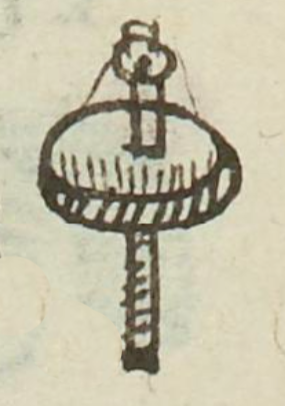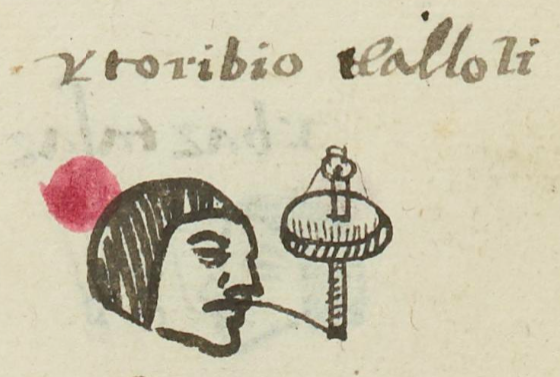Tlalolin (MH614r)
This black-line drawing of the simplex glyph for the personal name Tlalolin ("Earthquake" or shook) actually seems to show a toy, such as a top that could spin, in the form of an upright stick piercing a disc. Above the disc is another, smaller object, and two strings (one on each side) seem to reach down to attach to the disc's outer edge.
Stephanie Wood
Hieroglyphs of earthquakes often have the symbol for movement (olin) on top of a rectangular piece of land. Olin, by itself, can also speak to earthquakes. See below for examples.
This Nahua name, Tlalolin, is preceded in the gloss by a Christian first name (Toribio). He may have been named after Toribio de Benavente, also known as Motolinia ("One Who is Poor or Afflicted"). This was the first word he learned in Nahuatl, and he went on to learn the language well. He lived in the monastery in Huejotzingo. Doing a quick search for the name "Toribio" will produce an impressive result.
toribio tlalloli
Toribio Tlalolin
Stephanie Wood
1560
Jeff Haskett-Wood
temblores, terremotos, jugetes, movimiento

tlalolin, earthquake, https://nahuatl.wired-humanities.org/content/tlalolin
tlalolini, the earth quakes, https://nahuatl.wired-humanities.org/content/tlalolini
ol(in), movement or earthquake, https://nahuatl.wired-humanities.org/content/olin
la tierra tembló
Stephanie Wood
Matrícula de Huexotzinco, folio 614r, World Digital Library, https://www.loc.gov/resource/gdcwdl.wdl_15282/?sp=310st=image.
This manuscript is hosted by the Library of Congress and the World Digital Library; used here with the Creative Commons, “Attribution-NonCommercial-ShareAlike 3.0 License” (CC-BY-NC-SAq 3.0).







